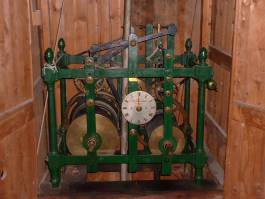7 THE CLOCK
7.1 The present clock was installed in 1845 but as a clock dial on the north face of the tower is shown in earlier engravings of the church it is evident that there was a clock before this. A catalogue issued in 1752 by the notable Pershore clockmakers Thomas & John Steight includes an entry under Berkshire for "Abington, a Clock and Chimes" - evidently supplied between about 1720 and 1750. However, it is unclear whether this entry in Steight's list relates to St.Nicholas's or to St.Helen's.
7.2 The clock is situated in a wooden enclosure on the north side of the clock room. It is a two-train movement in a cast-iron four-poster frame, showing the hours on a single skeleton dial on the north face of the tower and striking the hours on the tenor bell. It has deadbeat escapement. The pendulum hangs in the ringing room, and the clock weights descend in an enclosed weight-shaft in the north-east corner of the tower. It is still hand-wound.
 7.3 The clock was made by John Moore & Sons of Clerkenwell in 1845,
as indicated by the signature on the setting dial, which carries the inscription:
7.3 The clock was made by John Moore & Sons of Clerkenwell in 1845,
as indicated by the signature on the setting dial, which carries the inscription:
MADE BY.
JOHN MOORE & SONS,
CLERKENWELL.
LONDON. 1845.
The clock at Abingdon is mentioned in Moore's 1877 catalogue listing the clocks made by the firm for various churches and public buildings.
7.4 The clock was restored in 1886, as recorded by an additional inscription on the setting dial which reads
RESTORED BY PAYNE & SON 1886
ABINGDON.
A further engraved plate affixed to the mechanism records that the clock was restored in 1967 by Thwaites & Reed of London.
7.5 The present scheme (2005/6) includes the conversion of the clock to automatic electric winding. This will also allow the weight shaft in the ringing room to be removed. The clock will also be restored in connection with the work on the bells.
© Copyright 2006, Chris Pickford
 ABINGDON BELLS: Clock
ABINGDON BELLS: Clock